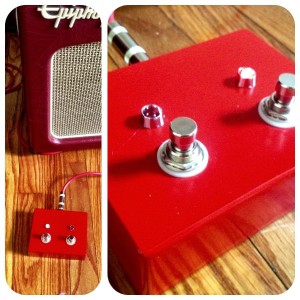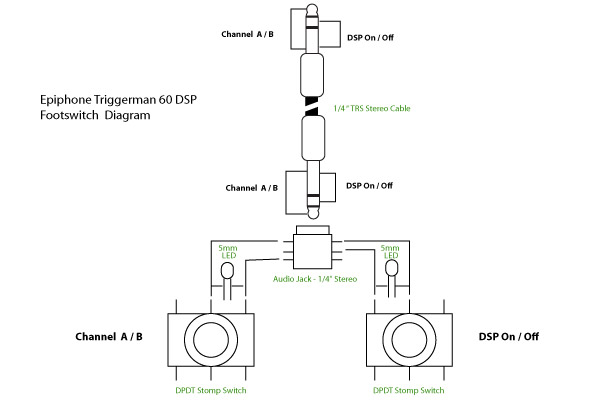DIY guitar amp footswitch for Epiphone Triggerman 60 (2 button)
 I few months ago, I had been eying a used Epiphone Triggerman 60 Guitar Amp at Morelock Music in downtown Knoxville. I had decided I had to get it, and had started planning to go pick it up. But before I could, my lovely and thoughtful girlfriend surprised me by bringing it home as a gift. You can’t beat that!
I few months ago, I had been eying a used Epiphone Triggerman 60 Guitar Amp at Morelock Music in downtown Knoxville. I had decided I had to get it, and had started planning to go pick it up. But before I could, my lovely and thoughtful girlfriend surprised me by bringing it home as a gift. You can’t beat that!
Unfortunately the original footswitch was not included with the amp. I had been searching the web for a replacement but I couldn’t find much information about the amp’s footswitch itself. I have very little experience with electronics, but the concept seemed simple enough, so I decided to make my own. I thought sharing this information might help someone else looking for a replacement footswitch. Since most amp footswitches are fairly similar, this will likely work for a lot of other amps out there.
Altogether, The parts for this 2 button DIY guitar amp footswitch cost only around $25. Here is what you’ll need.
Parts:
- 1 x Hammond 1590BB Die-cast Aluminum Box, Red ($9.25 from Amazon)
- 1 x SEISMIC AUDIO – SATRX-10 – Black 10′ 1/4″ TRS to 1/4″ TRS Patch Cable
($9.99 from Amazon)
- 2 x COM-11151 Stomp Switch – DPDT ($1.95 from Sparkun.com)
- 2 x COM-09590 LED – Basic Red 5mm ($0.35 each)
- 2 x COM-11147 LED Holder – 5mm ($0.50 each)
- 1 x Audio Jack – 1/4″ Stereo (right angle) COM-11144 ($0.95)
- Hook-Up Wire or Copper Wire
- Electrical Solder
Tools:
- Cordless Drill
- Soldering Iron
The Epiphone Triggerman 60 has 2 channels, as well as an on / off for the DSP effects, so a two button foot switch was in order.
To determine which connections of the pin would control each circuit, I started by simply plugging in a stereo 1/4 in cable into the footswith jack. I used a small copper wire to try out different connection combinations. Based on my tinkering, I drew up a wiring plan as seen below.
Here is the wiring plan I came up with:

Foot Switch Wiring Diagram
- Our Servers Recently Upgraded with Solid State Drives (SSD) for MySQL - October 24, 2013
- Keeping Your WordPress Site Secure - August 16, 2013
- DIY guitar amp footswitch for Epiphone Triggerman 60 (2 button) - May 29, 2013
- Middle Class Rut Website - May 17, 2013
- Launched: Daptone Records’ Super Soul Superstore Website - March 22, 2013
- Holiday Playlist – A hipster holiday alternative - December 18, 2012
- iFrankenDock: The Frankenstein’s Monster Of Car iPhone Docks. A DIY love story. - September 20, 2012
- Google, Yahoo & Bing announce support for new markup SEOs should keep an eye on - July 1, 2011
- Critical Components of Website Success - June 23, 2011
- Mobile app days are numbered. - June 14, 2011
